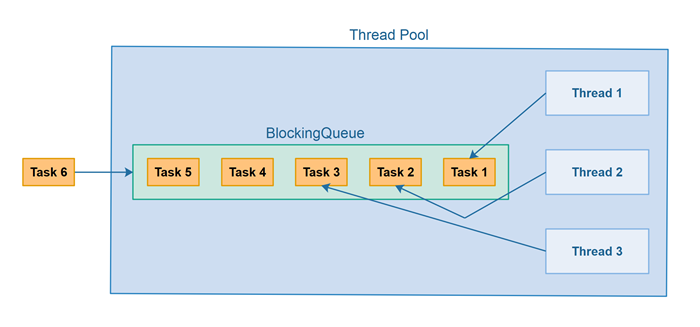线程池原理与实现
B站讲解视频:线程池原理与实现
线程池
线程池是什么
线程池(Thread Pool)是一种基于池化思想管理线程的工具,经常出现在多线程服务器中,如MySQL。
线程过多会带来额外的开销,其中包括创建销毁线程的开销、调度线程的开销等等,同时也降低了计算机的整体性能。线程池维护多个线程,等待监督管理者分配可并发执行的任务。这种做法,一方面避免了处理任务时创建销毁线程开销的代价,另一方面避免了线程数量膨胀导致的过分调度问题,保证了对内核的充分利用。

使用线程池可以带来一系列好处:
- 降低资源消耗(系统资源):通过池化技术重复利用已创建的线程,降低线程创建和销毁造成的损耗。
- 提高线程的可管理性(系统资源):线程是稀缺资源,如果无限制创建,不仅会消耗系统资源,还会因为线程的不合理分布导致资源调度失衡,降低系统的稳定性。使用线程池可以进行统一的分配、调优和监控。
- 提高响应速度(任务响应):任务到达时,无需等待线程创建即可立即执行。
- 提供更多更强大的功能(功能扩展):线程池具备可拓展性,允许开发人员向其中增加更多的功能。比如延时定时线程池ScheduledThreadPoolExecutor,就允许任务延期执行或定期执行。
线程池解决的问题
线程池解决的核心问题就是资源管理问题。在并发环境下,系统不能够确定在任意时刻中,有多少任务需要执行,有多少资源需要投入。这种不确定性将带来以下若干问题:
频繁申请/销毁资源和调度资源,将带来额外的消耗,可能会非常巨大。
对资源无限申请缺少抑制手段,易引发系统资源耗尽的风险。
系统无法合理管理内部的资源分布,会降低系统的稳定性。
接口
| Function example | Description |
|---|---|
| thpool_init(4) | Will return a new threadpool with 4 threads. |
| thpool_add_work(thpool, (void*)function_p, (void*)arg_p) | Will add new work to the pool. Work is simply a function. You can pass a single argument to the function if you wish. If not, NULL should be passed. |
| thpool_wait(thpool) | Will wait for all jobs (both in queue and currently running) to finish. |
| thpool_destroy(thpool) | This will destroy the threadpool. If jobs are currently being executed, then it will wait for them to finish. |
| thpool_pause(thpool) | All threads in the threadpool will pause no matter if they are idle or executing work. |
| thpool_resume(thpool) | If the threadpool is paused, then all threads will resume from where they were. |
| thpool_num_threads_working(thpool) | Will return the number of currently working threads. |
接口实现
thpool_init(int num_threads)
- 创建线程池基本结构
1 | typedef struct thpool_ |
- 初始化队列
1 | jobqueue_init(&thpool_p->jobqueue); |
- 创建线程池中的线程
1 | thpool_p->threads = (struct thread**)malloc(num_threads * sizeof(struct thread *)); |
- 初始化线程
1 | for (n=0; n<num_threads; n++){ |
关注点
对于资源申请失败的处理,防止异常退出和内存泄漏
由于malloc申请失败是不报错的,在malloc之后一定要判断返回的指针值是否为NULL。如果对于这个空指针不做处理,那之后对于空指针的操作会引发Segmentation Fault而程序直接core了。还有就是在异常处理中要对已经申请的资源释放掉,否则会引发内存泄漏
对于传值和传址的区分,传值传的是值的拷贝
如果对于指针理解得比较困难的开发者可以看看南科大于仕琪老师的C/C++教程
int thpool_add_work(thpool_ *thpool_p, void (*function_p)(void *), void *arg_p)
- 创建任务
1 | newjob = (struct job *)malloc(sizeof(struct job)); |
- 配置函数和函数参数
1 | newjob->function = function_p; |
- 将任务加入队列
1 | jobqueue_push(&thpool_p->jobqueue, newjob); |
关注点
对于队列没有任务时的处理
不是采用轮询的方式,而是使用条件变量,在有任务时唤醒条件变量
对于函数指针类型转换的处理
自定义的函数原型可以与api的原型不一致,但需要进行强制类型转换, (void *(*)(void *))里面中间的*表示当前为函数指针,右边的void *表示参数类型,左边的void *表示返回值类型。切记不要让编译器去做这种类型转换,可能会有意想不到的问题。(pthread_create参数里最后的函数指针的参数这样写好像就不必转换类型了)
1 | // int pthread_create(pthread_t *restrict thread, |
void thpool_destroy(thpool_ *thpool_p)
- 结构体元素的复位
1 | threads_keepalive = 0; |
- 通过条件变量的唤醒终止线程
1 | while (tpassed < TIMEOUT && thpool_p->num_threads_alive) |
- 任务队列的释放
1 | jobqueue_destroy(&thpool_p->jobqueue); |
- 其余堆上元素的释放
1 | int n; |
关注点
- 对于线程释放的处理
可以定义一个条件变量来唤醒所有线程,然后通过一个表示是否存活的布尔值来作为while循环的终止条件,达到优雅的释放
- 别漏,别漏,别漏
一定要细心检查,不要忘记释放堆上的资源
static void thread_hold(int sig_id)
- 注册信号量句柄
1 | // in function thread_do |
- 通过信号量发送暂停信号
1 | int n; |
void thpool_resume(thpool_ *thpool_p)
修改循环条件值
1 | (void)thpool_p; |
总结
我们明白了线程池是什么(What),线程池有什么用(Why)以及接口的具体实现(How)。这个线程池项目中有许多值得学习的地方,比方说对于条件变量的使用,对于资源的申请和释放方法,是很优质的开源项目。另外,项目里也有可以扩充的点,比方说把队列改成比方说把队列改成优先级队列,那这样要考虑的东西就更多了,比方说它任务是可抢占还是不可抢占的,有任务的调度顺序的变化,这可能会牵涉到线程逻辑的大修改,如果大家感兴趣的话可以试试~
参考资料
install_url to use ShareThis. Please set it in _config.yml.